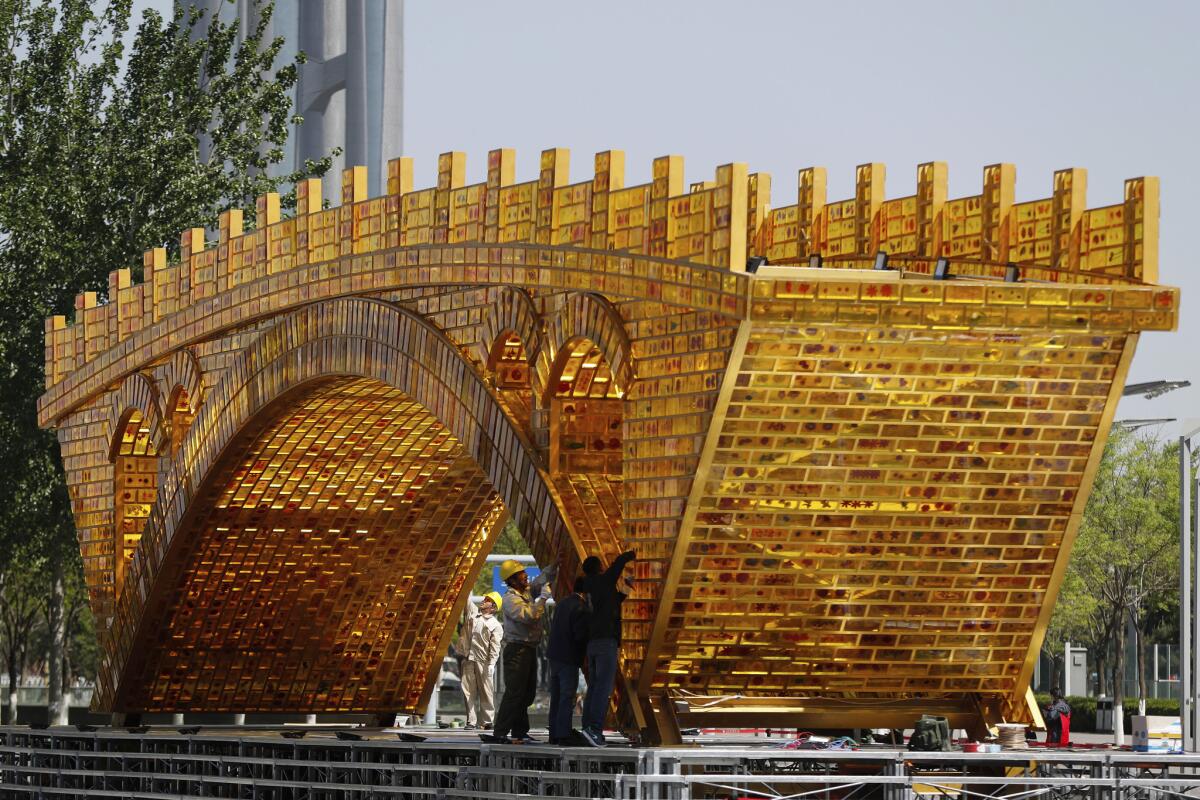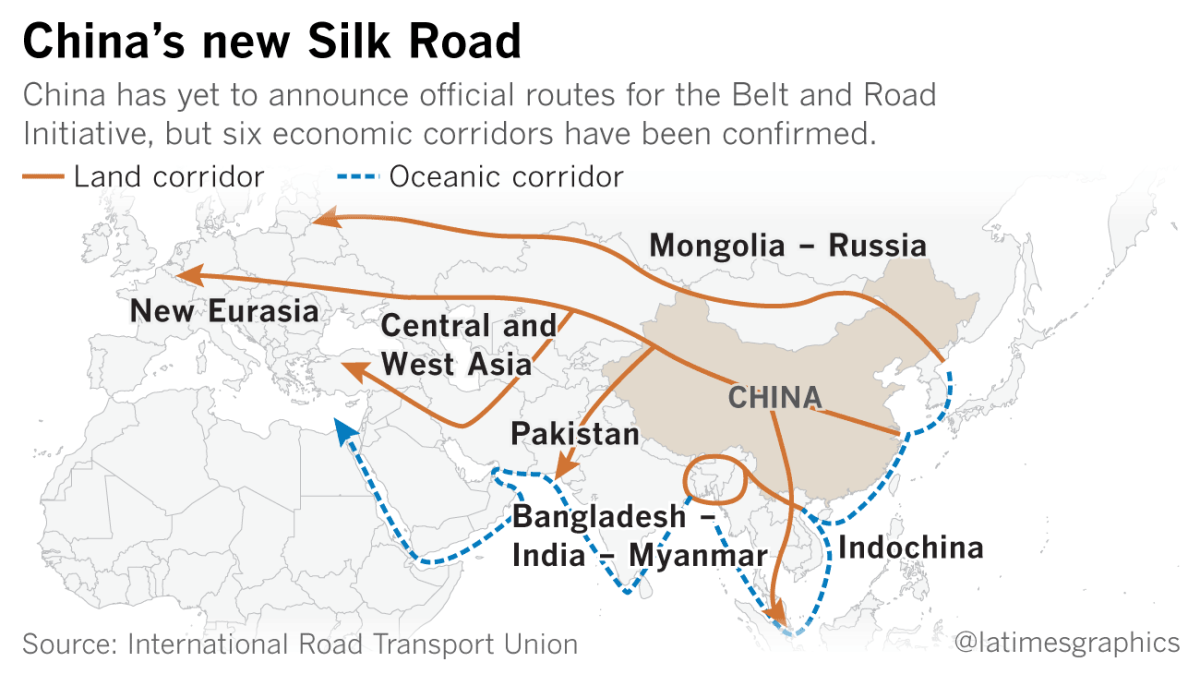Q&A: Globalization 2.0: How China’s two-day summit aims to shape a new world order

Nearly 30 leaders will convene in Beijing this Sunday to discuss a Chinese infrastructure plan.
- Share via
Last month, oil started flowing from a pipeline in coastal Myanmar to southern China, bypassing the Strait of Malacca choke point through which most of the larger nation’s crude imports pass by ship.
Earlier this year, Africa’s first electric transnational railway began running from landlocked Ethiopia to Djibouti, where China has set up a foreign military outpost. And last year, an inaugural freight train from eastern China arrived in Iran days after the easing of international sanctions on the Islamic republic.
Such projects represent China’s most ambitious steps yet to reshape half the globe into a world order tethered more to its orbit than the United States and Europe’s.
Chinese officials aim to further that goal when 28 heads of state arrive this Sunday for a two-day forum in Beijing, where they will negotiate a vision for the so-called Belt and Road Initiative. The multi-trillion dollar proposal is President

The path loosely re-creates ancient Silk Road trade routes through Central Asia and the Indian Ocean. China’s leaders call it an opportunity for global cooperation — orange banners lining Beijing highways promise “common prosperity” — but it will also spread Chinese investment and influence across Asia, Europe and Africa.
This forum offers Xi the chance to burnish his legacy before a Communist Party leadership shuffle this fall. It also allows him to reinforce China as a geopolitical alternative amid the United States’ turn inward under
State media has nicknamed the project Globalization 2.0.
“The West and East are switching their roles,” said Ni Lexiong, professor emeritus at Shanghai University of Political Science and Law. “China is awakened.”
Here’s some more on what you need to know about the initiative and its first major forum.

Whose belt, what road?
The program has undergone several name reincarnations — from Silk Road Economic Belt to One Belt, One Road. (Officials avoided the literal English acronym for the summit, which would have read BARF. They are calling it the Belt and Road Forum for International Cooperation, or BRF.)
The “belt” refers to a land route from western China through Central Asia to Europe. The “road” links to Europe by sea, connecting the country with Southeast Asia, the Middle East and North Africa. Some analysts liken it to the Marshall Plan, the American-led infrastructure initiative that rebuilt European allies after World War II.
Xi launched the mega-project in 2013 to fuel growth, reduce excess capacity in industries such as steel, and enhance China’s role abroad. Officials label it a “win-win solution” that benefits the entire region, particularly underdeveloped nations.
Four years on, its success is uncertain. Separate bridge and rail projects label themselves part of the initiative. No central institution tracks progress.
A train filled with textiles and T-shirts now chugs 7,500 miles from the Chinese factory town of Yiwu to London, cutting the delivery time of a ship by weeks. But it’s costlier and carries smaller amounts.
Certain efforts have sparked protests in places such as Sri Lanka, where some residents in the southern port town of Hambantota say Chinese firms take jobs and threaten national sovereignty. Pakistan is sending 10,000 soldiers to guard construction of an economic corridor, worth more than $50 billion, from militant attacks. India also sees the project as a challenge to its sovereignty, as it cuts through territory claimed by the country.
“China is going to really struggle to win people’s trust,” said Tom Miller, author of ”China’s Asian Dream,” a recent book about the New Silk Road. The forum needs to “persuade people what they are doing is win-win and not a double-win for China.”
Who’s attending the forum?
Hundreds of senior officials and dignitaries will convene at a Beijing lakeside retreat, including Russian President Vladimir Putin and Philippine President Rodrigo Duterte. North Korea also will send a delegation, despite deteriorating ties with its ally China.
Italian Prime Minister Paolo Gentiloni plans to attend, the one representative from the Group of Seven nations, a disappointment for China. Matthew Pottinger, one of the Trump administration’s main Asia policymakers, is expected to lead a small group. Heads of the
Bright orange and yellow signs plastered at Beijing bus stops announce the summit’s “mutual benefits.” Last week, the official New China News Agency ran more than 250 articles mentioning the initiative.
The state-run China Daily newspaper referred to the project as a “new trajectory for mankind.” It also released a series of videos this week featuring an American journalist telling his daughter a bedtime story — about the infrastructure plan.
What’s this meeting actually going to accomplish?
Analysts don’t anticipate big surprises. Most deals, they say, were scripted long in advance.
As with much in China, the symbolism counts.
Officials are expected to emphasize the globalization Xi championed in his January speech at the World Economic Forum in Davos, Switzerland. They’ll also try to soothe participants anxious about China’s intentions and Western countries worried about transparency and oversight.
How, for example, will the project address corruption in Central Asia or environmental standards in Laos? What are the consequences to investing in highly volatile regions with questionable human rights and business records?
“The summit is meant to satisfy, especially Western requests, for greater institutionalism of the whole project,” said Jan Gaspers, head of the European China Policy Unit at Mercator Institute for China Studies in Berlin. “There’s good reason to be skeptical.”
Who’s going to pay for this new Silk Road?
Right now, mostly China.
The government has created a $40-billion Silk Road Fund for the infrastructure projects. Money will also come from the Chinese-led Asian Infrastructure Investment Bank and the New Development Bank, a Shanghai institution for BRICS, an association of emerging markets led by Brazil, Russia, India, China and South Africa.
China could funnel investments worth up to $502 billion over the next five years, according to a recent Credit Suisse report. Most funds, it said, will flow into countries such as Russia, Egypt, the Philippines and Iran.
Much of Chinese financing, officials insist, will come in the way of loans. But lending money to less stable regions also creates new hazards.
“If it was easy to say, ‘We’re going to dump a bunch of money in Kazakhstan,’ it probably would have already been done by entities that have experience in this,” said Andrew Polk, director of China research at Medley Global Advisors in Beijing.
“There’s a risk China overextends itself abroad and some of this backfires.”
Nicole Liu in the Los Angeles Times’ Beijing bureau contributed to this report.
Meyers is a special correspondent.
Twitter: @jessicameyers
ALSO:
Sri Lankans who once embraced Chinese investment are now wary of Chinese domination
China’s bold gambit to cement trade with Europe — along the ancient Silk Road
As star attraction at Davos, Xi Jinping pushes globalization: ‘No one wins in a trade war’
Sign up for Essential California
The most important California stories and recommendations in your inbox every morning.
You may occasionally receive promotional content from the Los Angeles Times.







